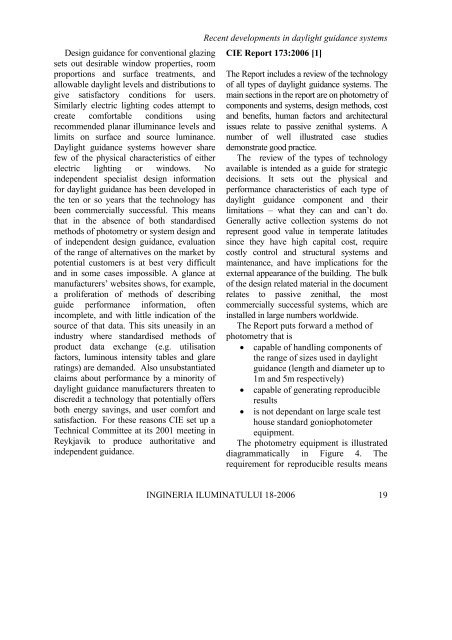This issue is sponsored by the Philips Romania, Lighting Division
This issue is sponsored by the Philips Romania, Lighting Division
This issue is sponsored by the Philips Romania, Lighting Division
Create successful ePaper yourself
Turn your PDF publications into a flip-book with our unique Google optimized e-Paper software.
Design guidance for conventional glazing<br />
sets out desirable window properties, room<br />
proportions and surface treatments, and<br />
allowable daylight levels and d<strong>is</strong>tributions to<br />
give sat<strong>is</strong>factory conditions for users.<br />
Similarly electric lighting codes attempt to<br />
create comfortable conditions using<br />
recommended planar illuminance levels and<br />
limits on surface and source luminance.<br />
Daylight guidance systems however share<br />
few of <strong>the</strong> physical character<strong>is</strong>tics of ei<strong>the</strong>r<br />
electric lighting or windows. No<br />
independent special<strong>is</strong>t design information<br />
for daylight guidance has been developed in<br />
<strong>the</strong> ten or so years that <strong>the</strong> technology has<br />
been commercially successful. <strong>Th<strong>is</strong></strong> means<br />
that in <strong>the</strong> absence of both standard<strong>is</strong>ed<br />
methods of photometry or system design and<br />
of independent design guidance, evaluation<br />
of <strong>the</strong> range of alternatives on <strong>the</strong> market <strong>by</strong><br />
potential customers <strong>is</strong> at best very difficult<br />
and in some cases impossible. A glance at<br />
manufacturers’ websites shows, for example,<br />
a proliferation of methods of describing<br />
guide performance information, often<br />
incomplete, and with little indication of <strong>the</strong><br />
source of that data. <strong>Th<strong>is</strong></strong> sits uneasily in an<br />
industry where standard<strong>is</strong>ed methods of<br />
product data exchange (e.g. util<strong>is</strong>ation<br />
factors, luminous intensity tables and glare<br />
ratings) are demanded. Also unsubstantiated<br />
claims about performance <strong>by</strong> a minority of<br />
daylight guidance manufacturers threaten to<br />
d<strong>is</strong>credit a technology that potentially offers<br />
both energy savings, and user comfort and<br />
sat<strong>is</strong>faction. For <strong>the</strong>se reasons CIE set up a<br />
Technical Committee at its 2001 meeting in<br />
Reykjavik to produce authoritative and<br />
independent guidance.<br />
Recent developments in daylight guidance systems<br />
CIE Report 173:2006 [1]<br />
The Report includes a review of <strong>the</strong> technology<br />
of all types of daylight guidance systems. The<br />
main sections in <strong>the</strong> report are on photometry of<br />
components and systems, design methods, cost<br />
and benefits, human factors and architectural<br />
<strong><strong>is</strong>sue</strong>s relate to passive zenithal systems. A<br />
number of well illustrated case studies<br />
demonstrate good practice.<br />
The review of <strong>the</strong> types of technology<br />
available <strong>is</strong> intended as a guide for strategic<br />
dec<strong>is</strong>ions. It sets out <strong>the</strong> physical and<br />
performance character<strong>is</strong>tics of each type of<br />
daylight guidance component and <strong>the</strong>ir<br />
limitations – what <strong>the</strong>y can and can’t do.<br />
Generally active collection systems do not<br />
represent good value in temperate latitudes<br />
since <strong>the</strong>y have high capital cost, require<br />
costly control and structural systems and<br />
maintenance, and have implications for <strong>the</strong><br />
external appearance of <strong>the</strong> building. The bulk<br />
of <strong>the</strong> design related material in <strong>the</strong> document<br />
relates to passive zenithal, <strong>the</strong> most<br />
commercially successful systems, which are<br />
installed in large numbers worldwide.<br />
The Report puts forward a method of<br />
photometry that <strong>is</strong><br />
• capable of handling components of<br />
<strong>the</strong> range of sizes used in daylight<br />
guidance (length and diameter up to<br />
1m and 5m respectively)<br />
• capable of generating reproducible<br />
results<br />
• <strong>is</strong> not dependant on large scale test<br />
house standard goniophotometer<br />
equipment.<br />
The photometry equipment <strong>is</strong> illustrated<br />
diagrammatically in Figure 4. The<br />
requirement for reproducible results means<br />
INGINERIA ILUMINATULUI 18-2006 19
















